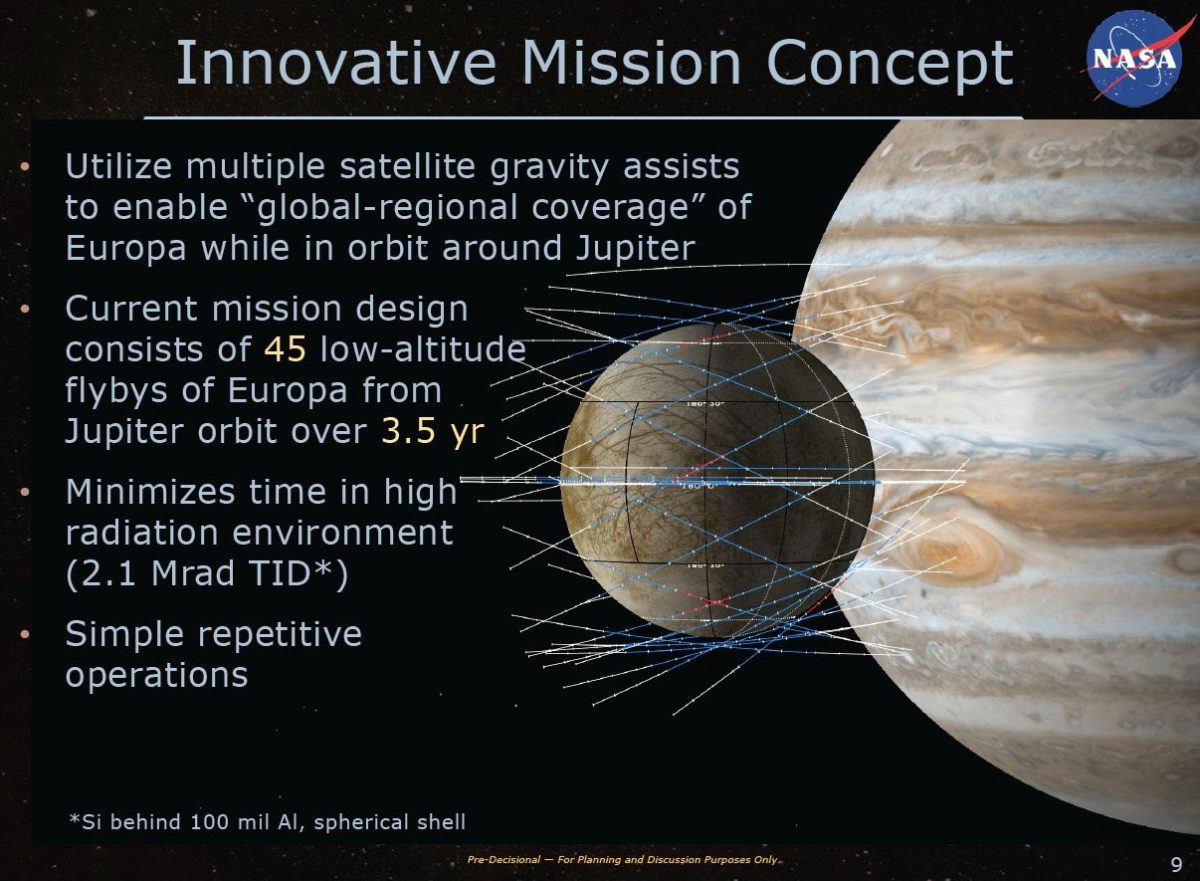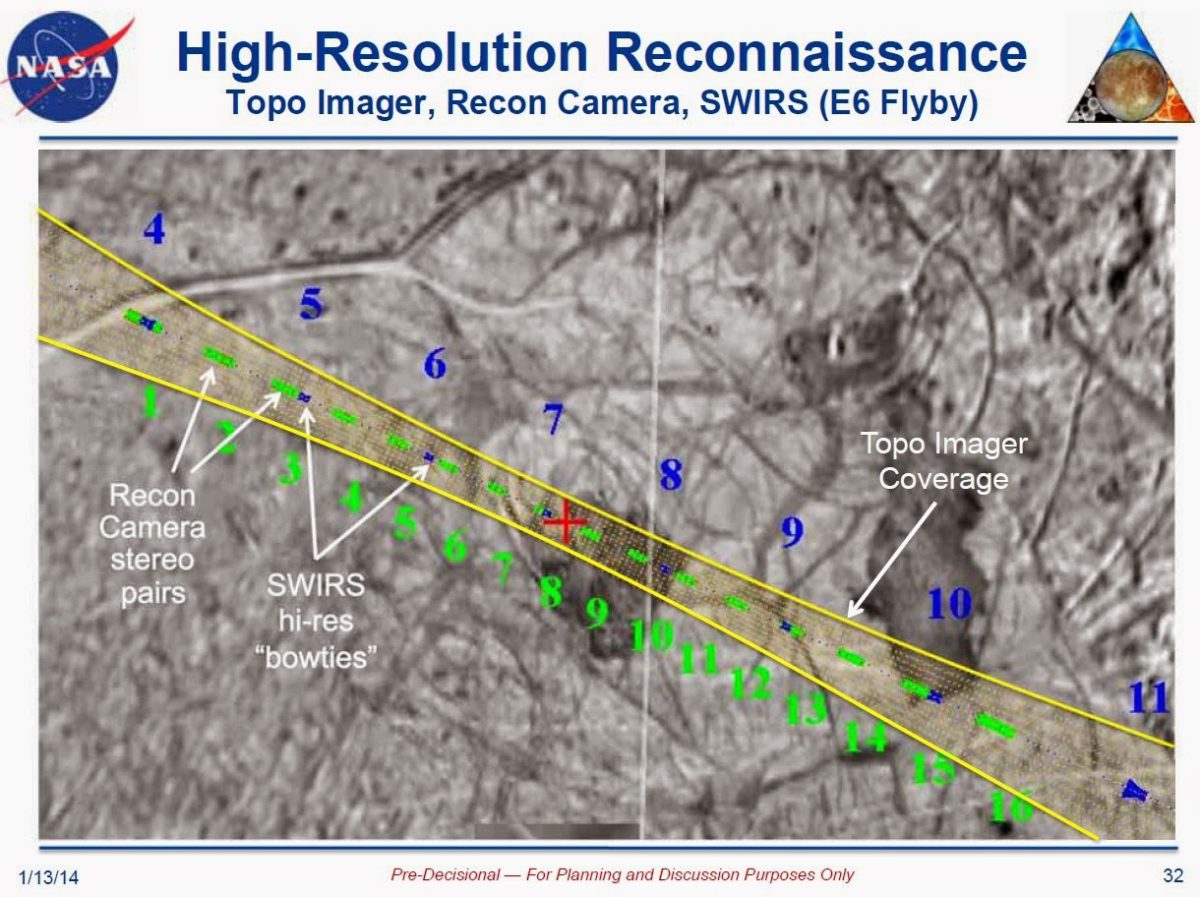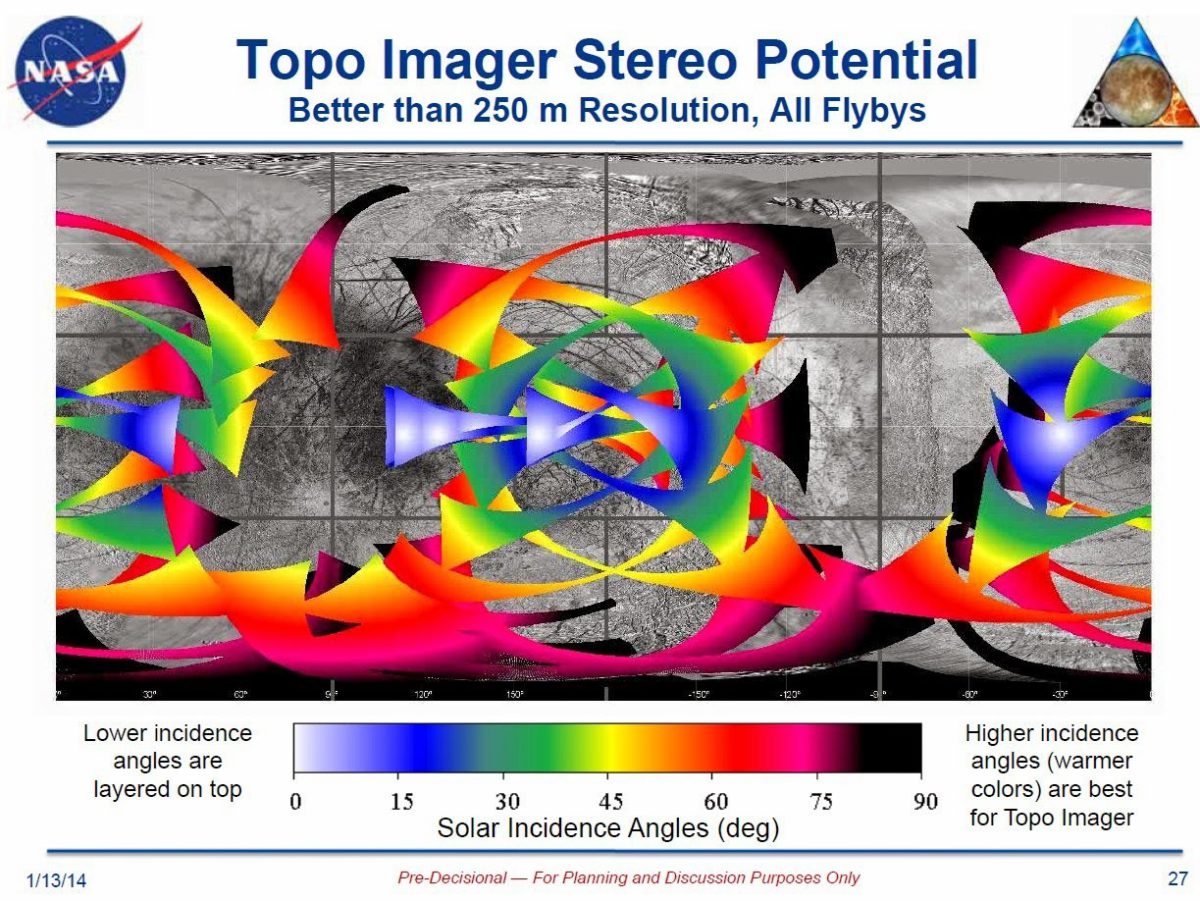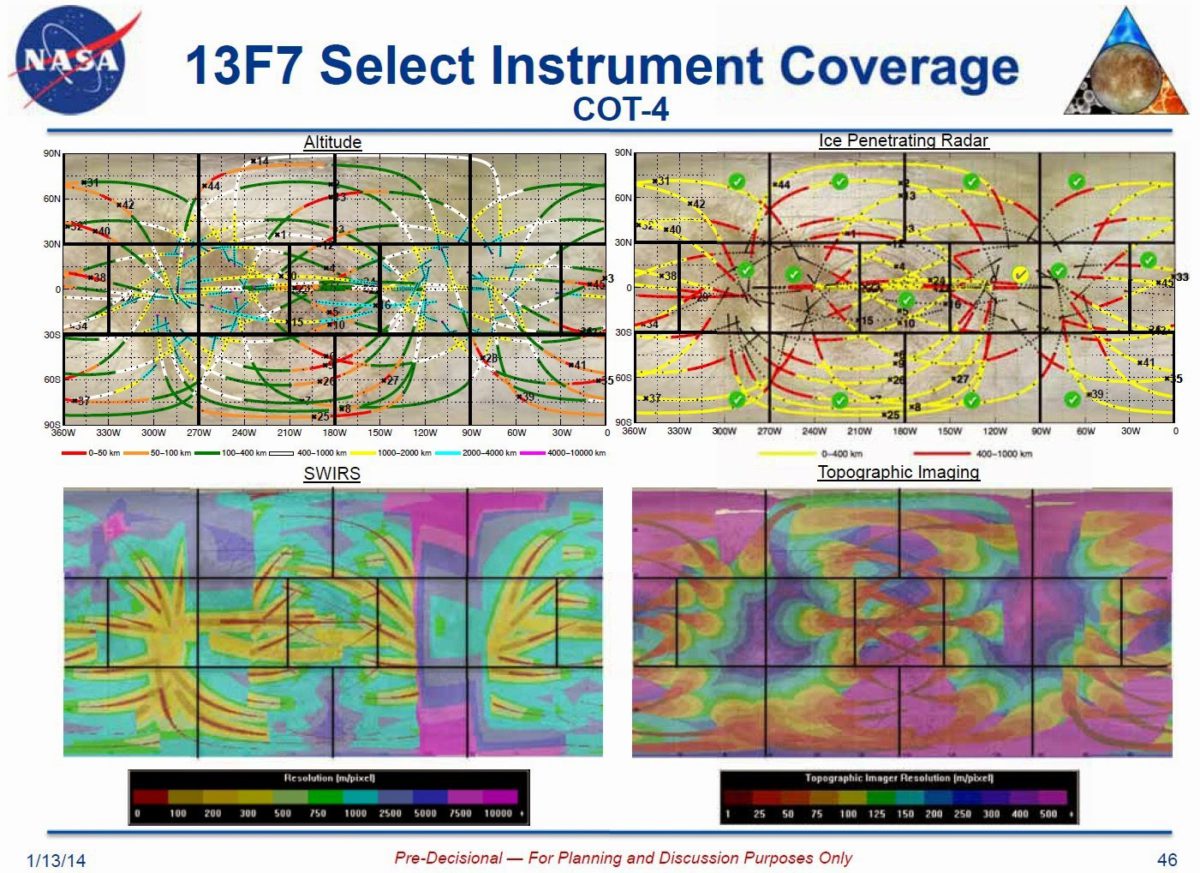Van Kane • May 14, 2014
A Reluctant Dance Towards Europa
or, Why A Credible Europa Mission is Likely to Cost ~$2B
For the last two years, NASA has been the shy partner refusing to get on the dance floor, and Congress has been the aggressive partner insisting on a dance now. Recently, NASA has said maybe on another night but only if it's a cheap date. While NASA says no for now, Congress looks to be willing to slip the band a cool $100M – on top of $150M already paid – to keep the music playing, but (to keep the metaphor going) has not been willing to fully commit itself to paying the bigger bill to rent the dance hall.
The dance, of course, is the continuing attempt by Congress to have NASA commit to a mission to explore Europa, and NASA managers' attempts to delay a mission well into the 2020s. NASA is also seeking ideas for alternatives to the current $2B Europa Clipper concept that would cost no more than $1B but that also would presumably be much less capable.
(I should make it clear that NASA's managers in this context are its most senior managers who have to try to balance the demands of an underfunded human spaceflight program against requests for several exciting science missions. They are in a tough spot between the restrictions placed on them by the President's budget office and Congress' requests, with too little money the common denominator.)
Compared to the budget waltz, the scientific case for a mission to Europa is compellingly simple. After the Earth, Europa is considered by many scientists to be the most likely location in the solar system as a home to present life. It has the key ingredients: an outer layer with lots of water (more than in the oceans of Earth) in contact with the rocky core (source of key elements needed to build the molecules essential for life) and energy (from the tidal heating supplied by Jupiter). And Europa has had a lot of time for life to evolve. Its oceans should have been present for most of the life of the solar system. (This distinguishes it from Enceladus where the weaker tidal flexing of Saturn may allow its internal ocean to freeze for long periods of time.) The recent observation of possible plumes spewing water into space where Europa's ocean could be easily sampled has just raised the desire for a dedicated Europa mission.

The Science Goals
In the 1990s and early 2000s, the Galileo orbiter made eleven of flybys past Europa. That mission all but proved the existence of a liquid ocean beneath the moon's icy shell and globally mapped the surface features and composition. Galileo, however, had a crippled main antenna that reduced the returned data to a tiny trickle of what had been planned, so medium and high resolution mapping of the moon covers only small areas. The spacecraft's vintage 1970's technology instruments also lacked the sophistication to identify important substances in the icy surface. It also did not carry instruments that could probe the structure of the icy shell to look for lakes within the shell or study the shell's interface with the ocean.
The standard progression for exploring a world is first flyby it (which Galileo did), then orbit it for globally studies, and then land on it for intensive studies in a single location. Unfortunately, Europa sits well within Jupiter's harsh radiation belts, and any affordable orbiter would have weeks to a handful of months to complete its studies and would carry a minimal instrument compliment.
JPL's engineers and scientists have developed an alternative strategy for the proposed Europa Clipper mission: Fly a highly capable spacecraft that orbits Jupiter, but that toe dips into the radiation belt and conducts its science during several dozen flybys. The radiation challenges are still significant, but the science that would have carried a cost of >$4B as an orbiter can now be done for ~$2B.
The several dozen flybys is key to the Europa Clipper's ability to replace an orbiter mission with a multiple-flyby mission.



I'll focus on just one set of requirements and how they link to several key investigations. To ensure that proposed mission achieves global coverage, the science team has divided Europa's map into 14 panels. The science goals require that the spacecraft fly over at least 8 of these panels at altitudes of less than 400 kilometers with a desired goal of 11 panels. Within each panel, the requirements specify that at least two close flybys occur in each on the Jupiter-facing hemisphere of Jupiter and three on the anti-Jupiter face. If the minimum 8 panels are evenly distributed between the pro- and anti-Jupiter hemispheres, then 20 flybys are needed to meet the minimum science goals.
This one set of requirements for regional measurements within a panel and a distribution of regional studies across the Europan globe enables several key studies:
- Characterize the ice shell and any subsurface water, including their heterogeneity, ocean properties, and the nature of surface-ice-ocean exchange.
- Characterize the distribution of any shallow subsurface water and the structure of the icy shell.
- Search for an ice-ocean interface.
- Correlate surface features and subsurface structure to investigate processes governing material exchange among the surface, ice shell, and ocean.
- Characterize regional and global heat flow variations.
- Understand the habitability of Europa's ocean through composition and chemistry.
- Characterize the composition and chemistry of the Europa ocean as expressed on the surface and in the atmosphere
- Determine the role of Jupiter's radiation environment in processing materials on Europa
- Characterize the chemical and compositional pathways in Europa's ocean.
- Understand the formation of surface features, including sites of recent or current activity, and characterize high science interest localities." (Quotes are from the Europa Clipper Science Traceability Matrix.)
The science goals similarly require a number of well distributed flybys to study the interaction of Europa's ocean with Jupiter's intense magnetosphere to estimate the depth and salinity of the ocean and to study tides to estimate the ice shell's thickness.
The current Europa Clipper mission concept goes well beyond the minimum science goals to deliver on almost all the extended goals that the science community has set. However, cutting the current mission concept from its 45 Europa flybys to a minimum of 20 or fewer flybys seems unlikely to cut the mission costs in half. Once you build and fly a spacecraft to Europa that can withstand 20 encounters, operate a suite of instruments, and return a large volume of data between encounters, I suspect that you've already incurred most of $2B cost (but remember that I am neither an engineer nor a planetary scientist).
Is Cheaper Credible?
NASA managers have formally asked if a credible Europa mission could be done for half the Clipper cost estimate—around $1B. This is a good news/bad news scenario. NASA took the initiative to propose an in-depth study by suggesting spending $15M next year ($85M less than the House of Representatives appears ready to approve for next year, see below). However, next year's study would be followed by several years before any mission conceived would actually begin development and a decade or more before it might launch.
NASA issued a Request For Information on concepts for a $1B mission. It has required that proposers, "meet the majority of the five science goals set forth in the Decadal Survey [priorities set by the scientific community], including the goal to characterize scientifically compelling sites to prepare for a potential future lander mission to Europa." Those scientific goals are, in priority order, to:
- Characterize the extent of the ocean and its relation to the deeper interior;
- Characterize the ice shell and any subsurface water, including their heterogeneity, and the nature of surface-ice-ocean exchange;
- Determine global surface compositions and chemistry, especially as related to habitability;
- Understand the formation of surface features, including sites of recent or current activity, and identify and characterize candidate sites for future in situ exploration;
- Understand Europa's space environment and interaction with the magnetosphere.
- While characterizing landing sites for future in situ exploration is the fourth scientific priority in the Planetary Decadal Survey, NASA places high programmatic priority on this goal to enable a potential future lander mission to Europa." (From the Request for Information.)
The request goes on to list the challenges of implementing the mission. "The primary challenges facing any mission to Europa involve the harsh radiation environment and planetary protection requirements...Planetary Protection requirements for Europa are very strict and involve ensuring that the probability of introducing a viable Earth organism into Europa is [less than one in 10,000]."
The request's details make it clear that proposers must do a solid amount of science and engineering analysis to show that they have a credible concept that could cost less than $1B (not including the launch costs) and make their case in 15 pages.
It is common for government agencies to issue these "Requests for Information" to learn whether an idea is credible and worth pursuing. This request doesn't commit NASA to any follow up studies, but if its managers judge any of the proposals to be credible, it presumably would follow through with more detailed analyses.
Is a $1B mission idea credible? I did a thought experiment in a previous post and concluded that technically it likely is. The Juno spacecraft that will orbit and study Jupiter cost ~$700M. A mission to fly by Jupiter's moon Io, deeper in Jupiter's radiation field, six or so times has been estimated to cost ~$1B. The European's JUICE mission will reach Jupiter next decade, flyby Europa twice, and then orbit the moon Ganymede for ~$1.2B.
If the goal simply is to fly by Europa a few times with a spacecraft with a small number of instruments, then by analogy with these other Jupiter missions, it likely can be done for ~$1B. The bar, though, for a scientifically credible mission is higher. A follow-on mission has to substantially enhance our scientific understanding of Europa to justify a cost of $1B to $2B. Most of the key studies identified by the science team require numerous flybys distributed across the globe.
However, Europe's JUICE 2020's JUICE mission to the Europa system is committed to two flyby of Europa with a highly capable spacecraft and instrument suite. To be justified, a NASA mission must produce significantly better science than the already funded JUICE mission will. (While the JUICE mission, which is still in design, it has committed to just two flybys of Europa. I suspect that if the engineers conclude it is safe, the mission's managers will consider one or two additional flybys closer to launch.)
So is there hope for a $1B mission that is scientifically compelling? Color me skeptical (and several of NASA's managers are reported to have said they are skeptical, too), but if there is, I suspect that it will come in one of two forms:
In a few months, we are likely to learn whether NASA received any proposals it considers worthy of further study. They key, though, will be whether the science community agrees that the mission meets the core requirements for understanding Europa. If it doesn't, then the community seems likely to recommend waiting until budgets allow the right mission to be flown. Missions to each outer planet or their moons occur only every couple of decades. Why do a sub-par job on the next mission to Europa and then have to do it over a decade or two later to get it right?
The Politics
In the introduction to this post, I said that NASA (and the President's budget office that writes NASA's budget requests) and Congress disagree on whether a Europa mission should begin now or wait to begin development several years from now.
The root of the disagreement, as in so many relationships, is money. Jupiter's harsh, electronics-frying radiation belts, make any mission that does more than a handful of flybys a technically challenging – read expensive – proposition. More than a decade's worth of technology development and mission studies has provided the solutions to most of the technical challenges. JPL's scientists and engineers have developed a killer proposal for a dedicated multi-flyby Europa Clipper mission. At ~$2B, this mission would be cheaper than the Curiosity rover mission currently exploring Gale crater on Mars.
Unfortunately, NASA's budget is oversubscribed. The only way to fit the Clipper mission into the budget is to either increase NASA's budget by several hundred million dollars a year for several years (which I would support as a US taxpayer!) or take the funding from other NASA programs.
We are left with this strange waltz in which Congress, which ultimately sets NASA's budget, has not increased the overall budget enough to fully fund the Clipper mission, but over the last two years provided $150M for advanced development work. This year, the House of Representatives is proposing to put another $100M in the pot for next year. If the Senate continues its previous support, it is likely to substantially match this funding.
At the other side of the dance floor, the President's budget managers and NASA's managers have made it clear that they don't want to commit to any Europa mission this decade because of the funding constraints. They also seem reluctant to commit to any $2B-class science mission because the last two large science missions (the James Webb Space Telescope and the Curiosity rover) went well over budget, which caused substantial harm to the overall science program.
As a result, today NASA is spending $150M because it's legally required to (Federal budgets in the US are laws) to advance a mission its senior managers don't want to do, at least for this decade.
The House of Representatives has released details of its proposed budget for next year. Where NASA proposed to spend $15M to study $1B mission concepts, the House is proposing to spend $100M. Under the House's bill none of the funding could go towards a $1B mission (which it doesn't see as credible) but only towards the full Europa Clipper mission.
We will have to wait for several weeks to see what the Senate proposes. It will be several months before we learn what the two houses of Congress ultimately compromise on for next year.
The Time is Now.
As a Planetary Defender, you’re part of our mission to decrease the risk of Earth being hit by an asteroid or comet.
Donate Today

 Explore Worlds
Explore Worlds Find Life
Find Life Defend Earth
Defend Earth

